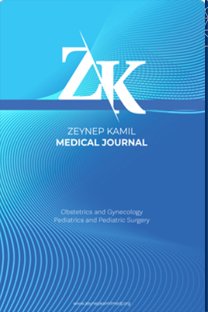Comparison of outcomes of frozen-thawed transfer of day 5 blastocysts and day 6 blastocysts
Comparison of outcomes of frozen-thawed transfer of day 5 blastocysts and day 6 blastocysts
___
- 1. Kovacic B, Vlaisavljevic V, Reljic M, Cizek-Sajko M. Developmental capacity of different morphological types of day 5 human morulae and blastocysts. Reprod Biomed Online 2004;8(6):687–94.
- 2. Park DS, Kim JW, Chang EM, Lee WS, Yoon TK, Lyu SW. Obstetric, neonatal, and clinical outcomes of day 6 vs. day 5 vitrified-warmed blastocyst transfers: Retrospective cohort study with propensity score matching. Front Endocrinol (Lausanne) 2020;11:499.
- 3. Hashimoto S, Amo A, Hama S, Ito K, Nakaoka Y, Morimoto Y. Growth retardation in human blastocysts increases the incidence of abnormal spindles and decreases implantation potential after vitrification. Hum Reprod 2013;28(6):1528–35.
- 4. Mirkin S, Nikas G, Hsiu JG, Díaz J, Oehninger S. Gene expression profiles and structural/functional features of the peri-implantation endometrium in natural and gonadotropin-stimulated cycles. J Clin Endocrinol Metab 2004;89(11):5742–52.
- 5. Shapiro BS, Daneshmand ST, Garner FC, Aguirre M, Ross R. Contrasting patterns in in vitro fertilization pregnancy rates among fresh autologous, fresh oocyte donor, and cryopreserved cycles with the use of day 5 or day 6 blastocysts may reflect differences in embryo-endometrium synchrony. Fertil Steril 2008;89(1):20–6.
- 6. Barrenetxea G, Delarruzea A, Ganzabal T, Jimenez R, Carbonero K, Mandiola M. Blastocyst culture after repeated failure of cleavage-stage embryo transfers: A comparison of day 5 and day 6 transfers. Fertil Steril 2005;83(1):49–53.
- 7. Shapiro BS, Richter KS, Harris DC, Daneshmand ST. A comparison of day 5 and day 6 blastocyst transfers. Fertil Steril 2001;75(6):1126–30. 8. Sunkara SK, Siozos A, Bolton VN, Khalaf Y, Braude PR, El-Toukhy T. The influence of delayed blastocyst formation on the outcome of frozenthawed blastocyst transfer: A systematic review and meta-analysis. Hum Reprod 2010;25(8):1906–15.
- 9. Yang H, Yang Q, Dai S, Li G, Jin H, Yao G, et al. Comparison of differences in development potentials between frozen-thawed D5 and D6 blastocysts and their relationship with pregnancy outcomes. J Assist Reprod Genet 2016;33(7):865–72.
- 10. Haas J, Meriano J, Laskin C, Bentov Y, Barzilay E, Casper RF, et al. Clinical pregnancy rate following frozen embryo transfer is higher with blastocysts vitrified on day 5 than on day 6. J Assist Reprod Genet 2016;33(12):1553–7.
- 11. Ferreux L, Bourdon M, Sallem A, Santulli P, Barraud-Lange V, Le Foll N, et al. Live birth rate following frozen–thawed blastocyst transfer is higher with blastocysts expanded on day 5 than on day 6. Hum Reprod 2018;33(3):390–8.
- 12. Desai N, Ploskonka S, Goodman L, Attaran M, Goldberg JM, Austin C, et al. Delayed blastulation, multinucleation, and expansion grade are independently associated with live-birth rates in frozen blastocyst transfer cycles. Fertil Steril 2016;106(6):1370–8.
- 13. Taylor TH, Patrick JL, Gitlin SA, Wilson JM, Crain JL, Griffin DK. Comparison of aneuploidy, pregnancy and live birth rates between day 5 and day 6 blastocysts. Reprod Biomed Online 2014;29(3):305–10.
- 14. Alpha Scientists in Reproductive Medicine and ESHRE Special Interest Group of Embryology. The Istanbul consensus workshop on embryo assessment: Proceedings of an expert meeting. Hum Reprod 2011;26(6):1270–83.
- 15. Zegers-Hochschild F, Adamson GD, Dyer S, Racowsky C, de Mouzon J, Sokol R, et al. The international glossary on infertility and fertility care, 2017. Fertil Steril 2017;108(3):393–406.
- 16. Tannus S, Cohen Y, Henderson S, Al Ma’mari N, Shavit T, Son WY, Dahan MH. Fresh transfer of day 5 slow-growing embryos versus deferred transfer of vitrified, fully expanded day 6 blastocysts: Which is the optimal approach? Hum Reprod 2019;34(1):44–51.
- 17. Kaye L, Will EA, Bartolucci A, Nulsen J, Benadiva C, Engmann L. Pregnancy rates for single embryo transfer (SET) of day 5 and day 6 blastocysts after cryopreservation by vitrification and slow freeze. J Assist Reprod Genet 2017;34(7):913–9.
- 18. Piccolomini MM, Nicolielo M, Bonetti TC, Motta EL, Serafini PC, Alegretti JR. Does slow embryo development predict a high aneuploidy rate on trophectoderm biopsy? Reprod Biomed Online 2016;33(3):398–403.
- 19. Levens ED, Whitcomb BW, Hennessy S, James AN, Yauger BJ, Larsen FW. Blastocyst development rate impacts outcome in cryopreserved blastocyst transfer cycles. Fertil Steril 2008;90(6):2138–43.
- ISSN: 1300-7971
- Yayın Aralığı: Yılda 4 Sayı
- Yayıncı: Ali Cangül
Anaphylaxis that develops following application of egg white on an area of burn
Zeynep Şengül EMEKSİZ, Serap ÖZMEN
Serum endocan concentration in women with placenta accreta
Önder TOSUN, Evrim BOSTANCI, İsmail DAĞ, Enis ÖZKAYA, Çetin KILIÇÇI, Ahmet ESER, Çiğdem YAYLA ABİDE, İlter YENİDEDE
Foreign body in esophagus of children with previous esophageal surgery history
Ayşenur CELAYİR, Olga Devrim AYVAZ, Bekir ERDEVE
İbrahim KALE, Cumhur Selçuk TOPAL
Nurdan EROL, Merve ÖZEN, Abdülkadir BOZAYKUT
Ahmet KALKIŞIM, Gökhan ÇELİK, Betül ÖNAL GÜNAY, Cenap Mahmut ESENÜLKÜ
Çağatay NUHOĞLU, Nevzat Aykut BAYRAK, Erkan YETMİŞ
Comparison of outcomes of frozen-thawed transfer of day 5 blastocysts and day 6 blastocysts
Negative pressure wound therapy in gynecological oncology
Sevgi KOÇ, Cihat Murat ALINCA, Taner TURAN, Caner ÇAKIR, Dilek YÜKSEL, Çiğdem KILIÇ, Nurettin BORAN, Günsu KİMYON CÖMERT, Fulya KAYIKÇIOĞLU
